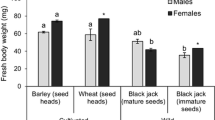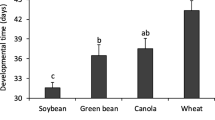Abstract
Laboratory and field studies were conducted with nymphs and adults of the Neotropical stink bug Runibia perspicua (F.) to evaluate their biology on plants. Total nymph mortality was ca. 13% on immature fruits of Brunfelsia australis Benth. (IFBA) and 90% on raw shelled peanuts, Arachis hypogaea L. (RSP); no nymphs survived on immature pods of green bean, Phaseolus vulgaris L., or on immature fruits of privet, Ligustrum lucidum Ait. Nymph developmental time was ca. 36 on IFBA and 55 days on RSP. Body weight was significantly greater when nymphs were raised isolated compared to those raised in groups. Adult feeding activity was greater than third instars on IFBA. Adult longevity on IFBA + cherry tomato, Solanum lycopersicum L. fruit, reached ca. 150 days. On IFBA, fecundity was 2.5 egg masses/female and 48.3 eggs/female; 25.6% of the eggs hatched. Adults did not reproduce on tomato. Body weight gain did not increase significantly for both sexes during the first four weeks of adult life on IFBA. In the field, plants of B. australis were surveyed in Passo Fundo, RS (28°15′S; 52°24′W). The majority of egg masses were deposited on the lower (abaxial) surface of leaves. Nymphs aggregated on immature fruits, and adults were seldom found on the plants. These are the first data on the performance of R. perspicua on B. australis indicating that this plant species is suitable to the bug’s biology.






Similar content being viewed by others
References
Backus EA, Serrano MS, Ranger CM (2005) Mechanisms of hopperburn: an overview of insect taxonomy, behavior, and physiology. Annu Rev Entomol 50:125–151. https://doi.org/10.1146/annurev.ento.49.061802.123310
Bertels A (1956) Entomologia Agrícola Sul-Americana. Ministério da Agricultura, Rio de Janeiro, Brazil, Série Didática 16, 485p
Biezanko CM, Bertholdi RE, Baucke O (1949) Relação dos principais insetos prejudiciais observados nos arredores de Pelotas nas plantas cultivadas e selvagens. Agrosciencia 2:156–213
Buckup L (1961) Os pentatomídeos do estado do Rio Grande do Sul (Brasil) Hemiptera-Heteroptera-Pentatomidae. Iheringia Ser Zool 16:1–24
Lima AMC (1940) Insetos do Brasil. 2° Tomo, Capítulo XXII Hemípteros. Escola Nacional de Agronomia, Rio de Janeiro, Brasil, Sér. Didática 3, 351p
Drechsel U (2015) Recent records and host plant reports of two species of Pentatomidae from Paraguay (Heteroptera: Pentatomidae). Paraguay Biodiversidad 2:7–11
Lucini T, Panizzi AR, Backus EA (2016) Characterization of an EPG waveform library for redbanded stink bug, Piezodorus guildinii (Hemiptera: Pentatomidae), on soybean plants. Ann Entomol Soc Am 109:198–210. https://doi.org/10.1093/aesa/sav156
Miles PW (1972) The saliva of Hemiptera. Adv Insect Physiol 9:183–255. https://doi.org/10.1016/S0065-2806(08)60277-5
Monte O (1939) Hemípteros fitófagos. O Campo 10:58–61
Panizzi AR (1997) Wild hosts of pentatomids: ecological significance and role in their pest status on crops. Annu Rev Entomol 42:99–122. https://doi.org/10.1146/annurev.ento.42.1.99
Panizzi AR, Hirose E, Oliveira EDM (1996) Egg allocation by Megalotomus parvus (Heteroptera: Alydidae) on soybean. An Soc Entomol Brasil 25:537–543
R Development Core Team (2016) R: a language and environment for statistical computing. R foundation for statistical computing, Vienna
Rider DA (1991) Rhyssocephala, new genus, with the description of three new species (Heteroptera, Pentatomidae). J N Y Entomol Soc 99:583–610
Rizzo HF (1976) Hemípteros de interés agrícola. Editorial Hemisferio Sur, Buenos Aires 69p
Silva FAC, Panizzi AR (2008) The adequacy of artificial oviposition substrates for laboratory rearing of Piezodorus guildinii (Westwood) (Heteroptera, Pentatomidae). An Soc Entomol Brasil 52:131–134
Silva AGDA, Gonçalves CR, Galvão DM, Gonçalves AJL, Gomes J, Silva MN, Simoni L (1968) Quarto Catálogo dos Insetos que Vivem nas Plantas do Brasil-Seus Parasitas e Predadores. Parte II, Tomo 1, Ministério da Agricultura, Rio de Janeiro, Brasil, 622p
Zwetsch A, Grazia J (2001) Revisão do gênero Runibia (Heteroptera, Pentatomidae, Pentatomini). Iheringia Ser Zool 91:5–28
Acknowledgments
We thank Natália Webber, Alice Agostinetto, and Júlio Minosso for help in the laboratory activities. We also thank Prof. Jocélia Grazia, Federal University of Rio Grande do Sul, for the insect identification and Prof. Branca A. M. Severo, University of Passo Fundo, for the plant identification.
Funding
This study was partially supported by a National Council of Research and Technology of Brazil (CNPq) grant 471517/2012-7 to ARP. This study was also supported by Embrapa Unit at Passo Fundo, RS.
Author information
Authors and Affiliations
Corresponding author
Ethics declarations
This study was approved by the Publication Committee of the Embrapa National Wheat Research Center, Passo Fundo, RS, Brazil, under number 5467/2017.
Additional information
Edited by Marcelo N Rossi - UNIFESP
Rights and permissions
About this article
Cite this article
Marsaro, A.L., Panizzi, A.R. & Lucini, T. Biology of a Neotropical Harlequin Stink Bug, Runibia perspicua (F.). Neotrop Entomol 47, 828–834 (2018). https://doi.org/10.1007/s13744-017-0572-5
Received:
Accepted:
Published:
Issue Date:
DOI: https://doi.org/10.1007/s13744-017-0572-5




